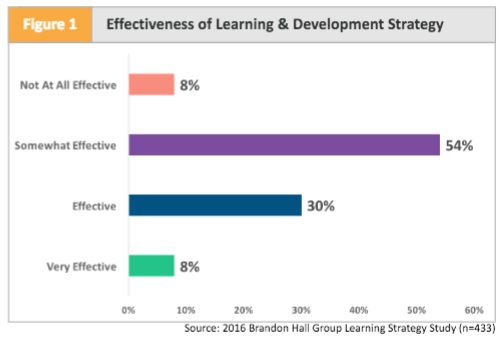
Learning Strategy: Key Statistics
- Over the next 12 to 15 months, two-thirds of organizations say their focus on experiential learning will increase and 73 percent say their focus on informal learning will increase.
- More than 20 percent of companies say their focus on formal learning experiences will decrease over the next 12 to 15 months.
- High-performing organizations (those with improved key performance indicators over the last year) do a far better job of delivering a well-rounded, blended learning experience than other organizations.
Source: 2016 Brandon Hall Group Learning Strategy Study (n=433)
Within the spectrum of Human Capital Management, learning is arguably the area that can have the most impact on individual and organizational performance. Unfortunately, organizations are having a difficult time not only developing robust strategies, but also executing in a way that is aligned with the overall business strategy.
One-quarter of organizations in Brandon Hall Group’s recent Learning Strategy research identified the people strategy (which includes learning) as the single most important strategy to achieve business success, ranking it higher than any other, including the business strategy. However, less than 40 percent of companies believe the L&D strategy is effective in helping achieve business goals:

The good news is that organizations are working on it. Brandon Hall Group’s 2016 Learning Strategy Study found that the top five priorities for learning and development include developing or revising the learning strategy (No. 2) and creating a stronger link between learning and performance (No. 3).
The study also showed that organizations plan to put a much heavier focus on development informal and experiential learning over the next 12 to 15 months than they have in the past. This article provides excerpts from Brandon Hall Group’s upcoming white paper, The State of Learning and Development 2016, based on results from its 2016 Learning Strategy Study, which surveyed 433 Learning and HR leaders from more than 20 countries and industries.
1. L&D Strategies Lack Effectiveness. When we ask organizations to describe their Learning and Development functions, we begin to see why less than 40 percent of organizations say their learning strategy is effective.
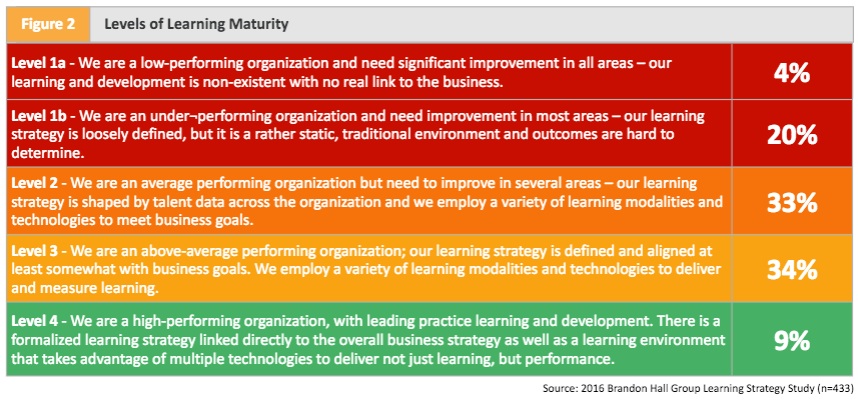
Nearly a quarter of organizations say they are either under- or low-performing (Level 1). This means they either don’t have a strategy at all, or their strategy isn’t really defined and definitely not linked to business outcomes.
It is an elite group of organizations (less than 10 percent) that has a formalized learning strategy aligned with the business, with the analytics to back it up (Level 4). Within this group, 83 percent of companies say their L&D strategy is either effective or very effective in helping to achieve business goals. Compare that to the 2 percent of the Level 1 organizations that can say the same.
Understandably, the robustness of the learning strategy trickles down throughout the actual delivery of learning, as high-performing learning functions deliver far more effective learning across all types than lower-performing ones.

In-person, instructor-led classroom training is still, by far, the No. 1 way in which learning is delivered, regardless of which level an organization may find itself. So for all the time, money, and energy these Level 1 organizations put into their classroom instruction, only 20 percent think they are very effective in their execution.
Even worse, only 4 percent say they are very effective at delivering a catalog of e-learning courses that is easy to use and works on multiple devices, and only 2 percent say they are very effective at giving employees clear development paths with prescriptive content to address skills and competencies. Remember from Figure 2, this Level 1 group states that most of their learning occurs in a “static and traditional” environment. Static and traditional. Yet the formal learning experience they are delivering is terribly ineffective.
2. A Truly Blended Experience Is the Key. As we discuss different learning experiences, whether they are formal, informal, or experiential, one thing is clear: High-performing organizations (HiPOs)—companies that have seen an annual increase in key performance indicators such as revenue, customer satisfaction, and market penetration—do a far better job of delivering a well-rounded, blended learning experience than their lower-performing counterparts. They are also more focused on creating a blended learning environment.
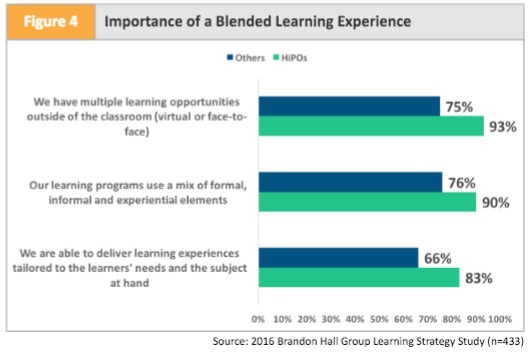
Not only are HiPOs trying to deliver a more blended learning experience, they also are focused on making learning more relevant and personalized for the learners. Here are some of the things HiPOs are doing more of in an effort to create this type of environment.
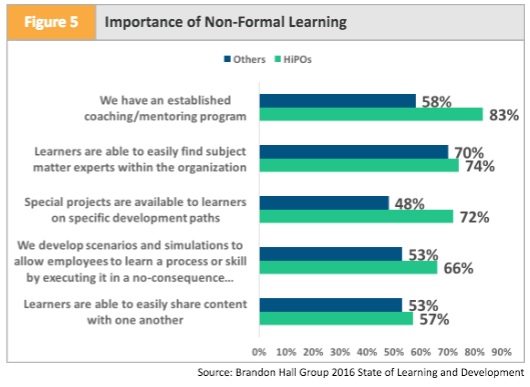
Coaching and mentoring programs are historically some of the most effective learning and development opportunities, and HiPOs are 43 percent more likely to see them as important or critical to their business. Special projects where learners can apply what they’ve learned in specific development paths also are seen as far more important to HiPOs than other organizations.
While companies in general are trying to deliver a more blended learning experience (only 3 percent said they did not have learning opportunities outside of the classroom), those companies that say delivering a blended learning experience as described in Figure 4 is important or critical are seeing far better results.
For example, 61 percent of organizations that said blended learning is important or critical to the business also said they were effective or very effective at improving individual performance. In contrast, only 17 percent of organizations that said blended learning was somewhat important or not at all important said they were effective or very effective at improving individual performance.
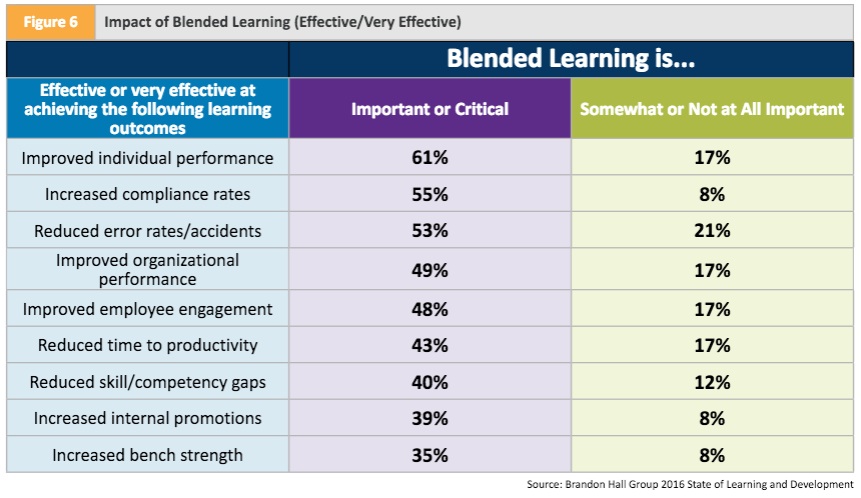
3. There Is a Lack of Alignment with Business Needs. In general, organizations are doing a poor job aligning learning with the needs of the business, and very few companies say that Learning is able to predict the needs of the business. Instead, we see Learning functions that are at best responsive, but just as likely to be reactionary—especially when it comes to learning that is not formal.
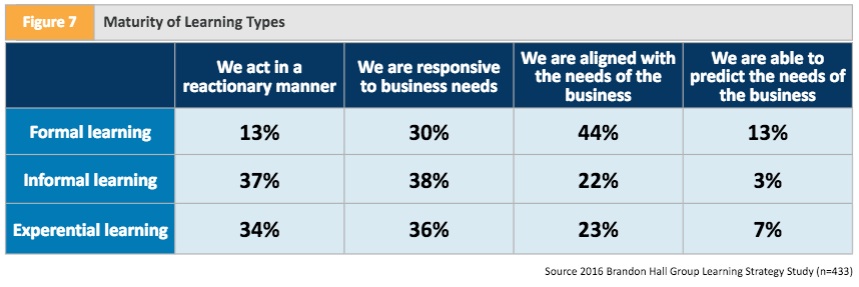
When it comes to formal learning, more than half of organizations believe they are aligned with the needs of the business, if not prepared to predict them. However, for the more subjective learning types, only about one-quarter say the same thing. In the case of both informal and experiential learning, more than one-third of companies simply are reacting to what is happening in the business, with no real alignment.
What makes this especially troubling is that according to 85 percent of companies, aligning the learning strategy with the business is either important or critical to achieving business goals. Even worse, only 18 percent of companies say they are ready to take action to create alignment. One-third of companies say they are prepared to address it, but not quite ready to take action. If alignment is this important, then there is much work to do in order to build it and translate it into business outcomes.
4. Focus on Informal and Experiential Learning Will Increase. Formal learning, whether instructor-led classroom training or e-learning course modules, is still the No. 1 way organizations deliver learning. However, as companies come to grips with the fact that very little of what people actually learn, retain, and apply comes from these settings, they are turning their attention to more informal and experiential learning opportunities.
In fact, almost three-quarters of organizations said they will increase or significantly increase their focus on informal learning, and almost two-thirds said the same about experiential learning. Meanwhile, the focus on formal learning actually may decrease somewhat.

This potential change is significant given the history of how organizations traditionally approach learning. It appears that after a long period of waiting and watching, companies will begin to explore a wider variety of learning experiences more in line with how people naturally learn.
In fact, when asked about the most important learning initiatives for achieving business goals, the No. 2 response was increasing the amount of experiential learning, cited by 78 percent of companies as either important or critical to the business. No. 3 was increasing the amount of informal learning (66 percent).
To that end, more than 40 percent of companies say they are either ready to address or take action on the increase in experiential learning. One-third say the same about informal learning. While this does not represent a majority of companies, it does show that a significant number of companies soon will be executing against the blended learning environment they desire to create.
David Wentworth is principal Learning analyst for Brandon Hall Group, an independent research and analyst firm with Human Capital Management practices in Learning & Development, Talent Management, Talent Acquisition, Leadership Development, and Workforce Management/HR.




